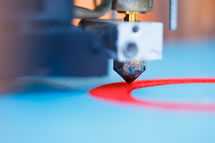Spaces for makers, hackers and coworkers on campus could support better learning, and entrepreneurial, outcomes. But what do they look like?
 Designated spaces for “tinkering” at some of the country’s most prestigious institutions may not only spur lifelong learning habits, but also produce social and technological innovations critical to today’s economy, says a new report.
Designated spaces for “tinkering” at some of the country’s most prestigious institutions may not only spur lifelong learning habits, but also produce social and technological innovations critical to today’s economy, says a new report.
Thanks to more broad access to the internet, as well as “breakthroughs” in manufacturing, innovation has been democratized, says a new research report by HermanMiller, in turn creating a “new driver for the economy.”
And it’s the forward-thinking institutions who understand this driver that have begun to implement spaces for makers (tinkerers), hackers (deconstructors), and coworkers (networkers).
There’s an “emerging culture of ‘learning by doing,’” notes the report–spearheaded by lead education researcher for HermanMiller, Susan Whitmer–and this is “shifting how future workers learn to innovate.”
Researchers were also interested in exploring these innovation spaces thanks to additional research, which showed a correlation between improving student learning and “maker spaces.” According to literature on Learning Theory, says the report, it’s been shown that “encounters with tools can promote self-discovery and new thinking, which support social and technological innovation.”
To better understand the shift in how students and workers learn to innovate, HermanMiller education researchers toured university campuses and city libraries with innovation spaces, and interviewed education and business thought leaders on the topic.
While the focus was on education, 13 innovation spaces were studied, some at public libraries, museums, and corporate campuses.
Knowing where to begin
Researchers first had to identify the three types of learners purported to take advantage of innovation spaces: Makers, Hackers and Coworkers. During preliminary explorations of these spaces, researchers found:
- Makers innovate through tinkering, which combines the “internet model of innovation with desktop manufacturing tools, resulting in much wider access to the tools needed to make things.” Tools usually used include computers, laser cutters, and 3D printers, and these tools are open to anyone interested in making a product in a relatively short time. The maker space also allows for building new skills in an environment that supports failure.
- Hackers innovate through deconstruction, with the goal of understanding how something works. In hacker spaces, learners usually work together on similar interest-based projects, which often include deconstructing and rebuilding computers, electronics or equipment. Researchers note that hacker spaces could be considered the pre-models of today’s coworker spaces.
- Coworkers innovate through networking, and usually consist of groups from different backgrounds and expertise. “The value of the coworking movement is in the community that is formed within shared working environments where learners work alongside each other, learn from each other, and build strong networks of knowledge and creativity,” explains the report.
Through further investigation, researchers found that most institutions began innovation spaces thanks to ideas from research, faculty, students, and staff on what they needed to be able to learn, create, and innovate.
After creating a very small community for an innovation space, leaders within an institution can better understand how the space might be planned, implemented, operationalized, and scaled to reach maximum potential on campus.
Common characteristics
Each site/campus had its own unique approach to innovation spaces, emphasizes the report, and no established framework exists for what an innovation space should look like. However, there are common characteristics of each space:
- Multiple resources at the learner’s disposal
- An interdisciplinary perspective
- A shared space for making, hacking, and coworking in one centrally located site
- Maker spaces in public libraries had similar tools in spaces designed to attract both novices and experts.
- Stand-alone hacker spaces had a range of equipment types, but the focus was more on enhancement of skills through collaboration than on the equipment.
- Coworker spaces both aimed to build a community of like-minded people, as well as one with diverse ideas.
“Each of the sites [visited] in our study offered some combination of those traits,” said the report.
Notable examples
According to the report, there were four higher education innovation spaces that exemplified these characteristics. However, each space also showed room for improvement.
For example, the Invention Studio at GeorgiaTech includes space for all three types of innovation learners, with a myriad of resources for all makers, hackers and coworkers. But space was limited and the location was in an Engineering building, limiting approachability for other disciplines.
Another example includes the SHED at the University of California Berkeley, which has an undergraduate-developed and managed maker/hacker space that serves as an inspiration for the new Jacobs Institute for Design Innovation. However, the space should also incorporate resources that support tinkering and coworking.
“While theorists suggest that the process of making is a ‘gateway to deeper engagement’ between users from a variety of disciplines, none of the spaces we studied were located in the center of campus, where they would be accessible and approachable to students from all disciplines,” states the report. “At the moment, there is no established framework for planning a centrally located, on-campus innovation space that could benefit all students, and a lack of empirical evidence to support the benefits of on-campus innovation spaces may create roadblocks to future projects.”
For more information on the report, and well as in-depth findings, read the full report “Innovation Through Experience: Reshaping Learning Space for Makers, Hackers, and Coworkers.”
- 25 education trends for 2018 - January 1, 2018
- IT #1: 6 essential technologies on the higher ed horizon - December 27, 2017
- #3: 3 big ways today’s college students are different from just a decade ago - December 27, 2017

